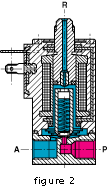
Two types of pneumatic actuators are available: double-acting and spring-return. The solenoid (pilot) valve receives an electric signal which energizes its coil and allows air to flow either in or out of the pneumatic actuator, subsequently opening/closing the ball valve. Remote piloting can also be achieved utilizing the air supply port(s). These actuators don’t require a motor, but electricity is necessary when paired with an integral solenoid valve which is commonly referred to as a pilot valve. Pneumatic actuators rely on compressed air or gas as the primary power source. From the closed position, it’s turned 90° counterclockwise to open and 90° clockwise to close. The ball is contained within a body and uses a stem that is connected to the output shaft - in this case, of a pneumatic or electric actuator. The hole is referred to as the port or orifice and when opened, it’s aligned with the valve body to permit flow. A ball valve is a quarter turn valve that uses a ball with a hole drilled through it to control the flow of media. If you’re not familiar with how a ball valve works, it’s pretty simple.

electric actuators - which is best for your application? In general, pneumatically actuated ball valves serve the same purpose as electrically actuated ball valves: to control the flow of media.īoth types of actuation have their pros and cons, so it’s important to be sure you select the right one for your intended application. Electrically Actuated Ball Valves: Which Should You Use?


 0 kommentar(er)
0 kommentar(er)
